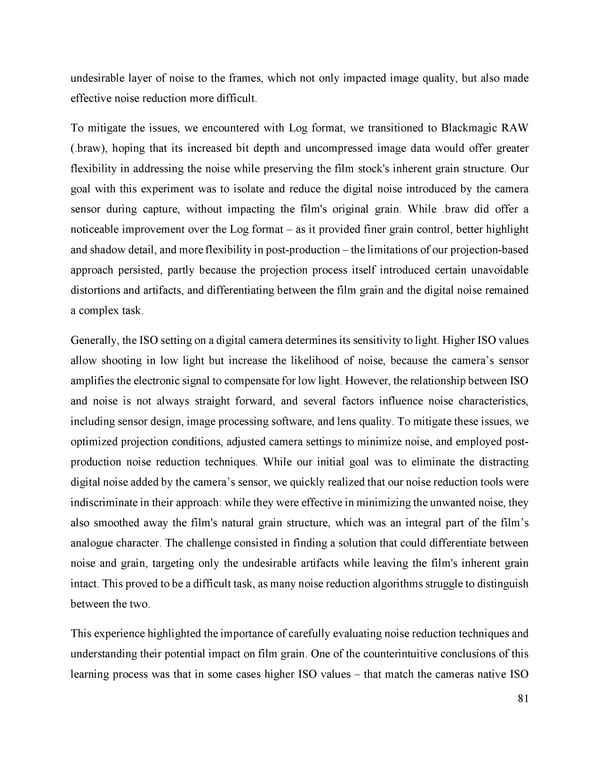undesirable layer of noise to the frames, which not only impacted image quality, but also made effective noise reduction more difficult. To mitigate the issues, we encountered with Log format, we transitioned to Blackmagic RAW (.braw), hoping that its increased bit depth and uncompressed image data would offer greater flexibility in addressing the noise while preserving the film stock's inherent grain structure. Our goal with this experiment was to isolate and reduce the digital noise introduced by the camera sensor during capture, without impacting the film's original grain. While .braw did offer a noticeable improvement over the Log format – as it provided finer grain control, better highlight and shadow detail, and more flexibility in post-production – the limitations of our projection-based approach persisted, partly because the projection process itself introduced certain unavoidable distortions and artifacts, and differentiating between the film grain and the digital noise remained a complex task. Generally, the ISO setting on a digital camera determines its sensitivity to light. Higher ISO values allow shooting in low light but increase the likelihood of noise, because the camera’s sensor amplifies the electronic signal to compensate for low light. However, the relationship between ISO and noise is not always straight forward, and several factors influence noise characteristics, including sensor design, image processing software, and lens quality. To mitigate these issues, we optimized projection conditions, adjusted camera settings to minimize noise, and employed post- production noise reduction techniques. While our initial goal was to eliminate the distracting digital noise added by the camera’s sensor, we quickly realized that our noise reduction tools were indiscriminate in their approach: while they were effective in minimizing the unwanted noise, they also smoothed away the film's natural grain structure, which was an integral part of the film’s analogue character. The challenge consisted in finding a solution that could differentiate between noise and grain, targeting only the undesirable artifacts while leaving the film's inherent grain intact. This proved to be a difficult task, as many noise reduction algorithms struggle to distinguish between the two. This experience highlighted the importance of carefully evaluating noise reduction techniques and understanding their potential impact on film grain. One of the counterintuitive conclusions of this learning process was that in some cases higher ISO values – that match the cameras native ISO 81
 Lost Analogue: Exploring Film, Music, and Interdisciplinary Methods in Education Page 81 Page 83
Lost Analogue: Exploring Film, Music, and Interdisciplinary Methods in Education Page 81 Page 83